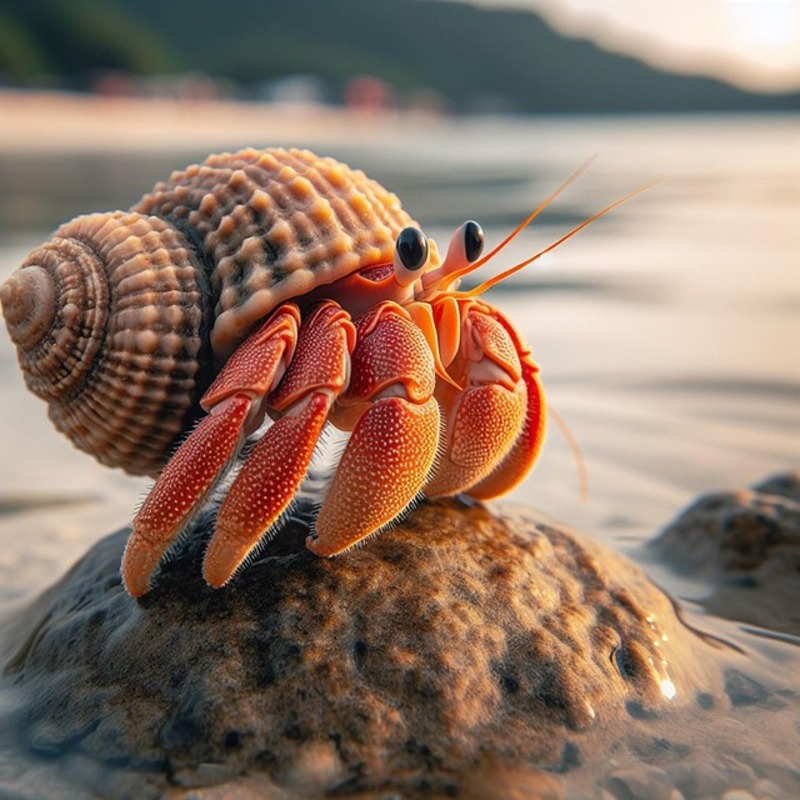
Hermit Crab as Pets
Published on June 26, 2025
Hermit crabs, with their quirky personalities and constant shell-swapping, have become popular pets for those seeking something a little different. Often sold as low-maintenance starter pets, the truth is that these fascinating crustaceans have very specific and often misunderstood needs. They are not 'starter pets' in the sense of being easy; rather, they are unique creatures that thrive when their complex environmental and social requirements are met. With proper care, hermit crabs can live for many years, offering a quiet yet engaging presence in your home.
This guide will delve into the essential aspects of caring for hermit crabs, ensuring you can provide them with a happy, healthy, and stimulating environment.
Understanding Hermit Crabs: More Than Just a Shell
Most pet hermit crabs are land hermit crabs, primarily Coenobita clypeatus (Purple Pincher) or Coenobita compressus (Ecuadorian). They are nocturnal, social, and require a humid, warm environment to survive. They do not breed in captivity, and all pet store hermit crabs are wild-caught.
1. The Essential Habitat: The Crabitat
A proper 'crabitat' is the cornerstone of hermit crab health. A glass aquarium with a secure, tight-fitting lid (to maintain humidity) is ideal.
- Tank Size: A minimum of a 10-gallon tank for 1-2 small crabs, but a 20-gallon long or larger is highly recommended for more space and better humidity/temperature stability. Hermit crabs need room to roam and climb.
- Substrate: A deep layer (at least 6 inches, or 3x the height of your largest crab) of a mixture of play sand and coco fiber (Eco Earth) is crucial. This allows them to burrow, which is essential for molting and de-stressing. The substrate should be sandcastle consistency – damp enough to hold its shape.
- Temperature: Maintain a consistent temperature between 75-85°F (24-29°C). Use an under-tank heater (UTH) attached to the side or back of the tank, above the substrate line, to provide ambient heat.
- Humidity: Crucial for their gill-like breathing. Maintain 75-85% humidity. Use a hygrometer to monitor. Misting daily and having proper water pools help.
2. Water, Water Everywhere (Two Kinds!)
Hermit crabs need access to two types of water, in separate, non-metal dishes deep enough for them to fully submerge:
- Dechlorinated Fresh Water: Use a high-quality dechlorinator for tap water.
- Saltwater: Use marine-grade aquarium salt (not table salt) mixed with dechlorinated water to the correct salinity (e.g., 1.025 specific gravity).
Both dishes should have a ramp or natural sponge to help smaller crabs climb out.
3. Diet: A Varied Menu is Key
Hermit crabs are omnivores and scavengers. A varied diet is essential for their health and shell quality. Avoid commercial hermit crab foods that contain ethoxyquin, copper sulfate, or BHT/BHA.
- Proteins: Cooked meat (chicken, shrimp), fish, bloodworms, crickets.
- Fruits & Vegetables: Apple, banana, mango, berries, leafy greens, carrots (organic where possible).
- Calcium Sources: Cuttlebone, crushed eggshells, oyster shell.
- Chitin: Essential for exoskeleton health, found in exoskeletons of insects or shrimp.
- Leaf Litter: Oak, maple, or Indian almond leaves provide foraging opportunities and tannins.
Offer fresh food daily and remove uneaten portions to prevent mold.
4. Shells, Shells, and More Shells!
Hermit crabs need a constant supply of appropriately sized, natural (not painted) shells. They will switch shells as they grow or simply because they prefer a different one. Provide at least 3-5 shells per crab, in various sizes and openings, slightly larger than their current shell. Popular choices include turbo shells.
5. Social Needs: Crabs Need Friends
Hermit crabs are social animals and thrive in groups. Keeping them alone can lead to stress, lethargy, and a shorter lifespan. Aim to keep at least two or three together, ensuring you have enough space and resources for all of them.
6. Enrichment and Climbing
Provide plenty of climbing opportunities with cholla wood, cork bark, plastic plants, and even plastic mesh. Hermit crabs are natural climbers and foragers, and enrichment prevents boredom and promotes activity.
Molting: A Critical Process
Molting is how hermit crabs grow. They will bury themselves in the substrate for weeks or even months. During this time, they shed their exoskeleton and grow a new, larger one. It is crucial **not to disturb a molting crab**. Ensure the substrate is deep enough and humidity is stable. They will eat their old exoskeleton for calcium and chitin.
Conclusion
Hermit crabs are not the simple, disposable pets they are often portrayed to be. They are complex, long-lived creatures with specific needs that, when met, allow them to thrive. By providing a proper crabitat, varied diet, ample shells, and social interaction, you can enjoy these fascinating crustaceans for many years to come.